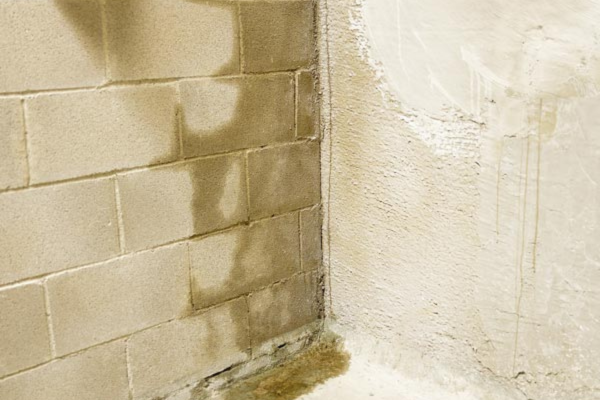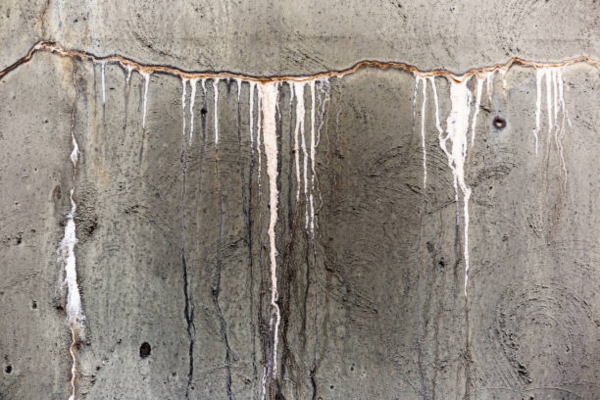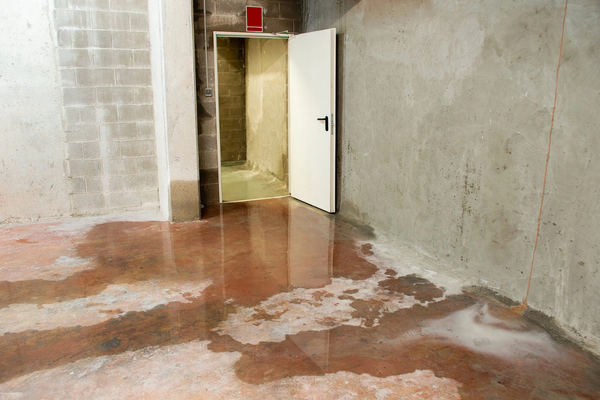Can water damage concrete, in short, yes. Concrete is often referred to as durable and strong, yet it became number one choice for residential and commercial building construction. However, even such durable material cannot successfully go through some environmental challenges. One of the big threats is water. Can water damage concrete? The simple answer is yes, it can. Even though concrete is quite robust, too long exposure to water may advance several problems in visual and structural respects.
This blog explains how water damages concrete, the science behind concrete’s vulnerability to water, and what practical measures may be taken against the incidence of water-induced damage and repairs. Understanding concrete vulnerability is vital, especially for those house owners and property managers who work in areas prone to water. Proper knowledge with preventive steps might make a lot of difference to the life of concrete structures.
Concrete Composition: Why Water Can Damage Concrete
It is a composite material with some very specific vulnerabilities. Understanding how water can damage concrete starts with understanding what concrete is made of, and why its composition lends itself to moisture-related problems.
Concrete Basics: Cement, Water, and Aggregate
The three basic components of concrete are cement, water, and aggregate, the latter containing a mixture of sand, gravel, or crushed stone. It is basically a mixture with cement as its binder, which ties the aggregates together. Water is required to mix it. It is made by a kind of chemical reaction called hydration when cement and water are mixed, and this allows it to form a hard, stone-like body. The aggregate adds bulk to it and increases the strength of the concrete.
While water is a necessary ingredient in the manufacture of concrete, the history between water and concrete does not stop right after hydration. Even after curing, concrete is still porous-it contains small holes and capillaries. These pores may allow seepage of water into it, thus setting the stage for its possible damage.
Porosity: How Concrete’s Nature Makes It Vulnerable to Water Infiltration

Concrete is porous; that is one of its basic characteristics. Behind its apparently solid appearance, it contains a three-dimensionally interconnected pore system with microcracks. These defects offer a route for water and moisture to ingress into the material. In such pores, water can deeply penetrate into the structure, normally with dissolved minerals, salts, and even pollution agents responsible for further deterioration.
The porosity would depend on the mix of the concrete, the quality of the ingredients, and the curing process. With more porosity, there is more chance of water damage, especially if the location is prone to rain or moisture in the atmosphere or temperature changes. In that respect, that underlines how important it is to understand the possibility of water risk to concrete.
Water and Concrete Strength: How Water Affects the Durability of Concrete
Water plays an important role in the strength and durability of concrete through the hydration process. During this process, cement reacts with water to produce a hardened calcium silicate hydrate gel, the glue or binder that holds the aggregate together and imparts strength to concrete. Too much water, however, weakens the bond. Using too much water in the initial mixing creates a greater volume of pores, thus making the concrete weaker and more prone to damage.
Besides that, even after it is cured, undue exposure to water impairs its structure. Water may leach out the components that are essential for concrete, erode its surface, and develop the degradation of reinforcement embedded in it, such as steel rebars. This multi-interaction between water and concrete is one of the complex reasons why water management plays a very significant role in the longevity of concrete structures.
This understanding of such basic features of concrete helps explain the origins of water damage and underlines the need for proper precautionary measures. In the following sections, we turn our attention to the types of damage that can be caused by water and protection measures against these damages to save your concrete investments.
How Water Can Damage Concrete: Understanding the Risks
Concrete does appear to be pretty impervious; the reality, though, is that water can have serious effects on durability and lifespan. In this section, we shall delve deep and try to explain in detail the way water enters concrete and the different types of destruction it can cause over time.
Water Infiltration and Concrete Porosity: How Water Penetrates and Compromises Concrete
The main reasons concrete would be vulnerable to water infiltration include the porosity of concrete. Concrete is not as solid as it appears but contains a network of small cracks and pores whereby moisture can enter the pathways. It is that easy for the water to find its way deep into the material and cause potential long-lasting damage.
Mechanism of Water Infiltration in Concrete
Water can find its way into concrete both from surface cracks and at a microscopic pore level. Cracking may come from shrinkage, structural stress, or externally applied loads, these offer direct water entry avenues. Pores are naturally inherent in concrete, even in properly cured concrete. Once inside the minute openings, the water carries destructive minerals and chemicals that accelerate concrete breakdowns.
Several factors represent the dependence of water penetration. For example, poor drainage systems around a structure have the potential to make standing water continuously saturate concrete surfaces at an increased rate of damage. Severe weather conditions, such as heavy rainfall or flooding, are likely to sabotage these drainage systems and make concretes even more vulnerable. Repeated exposure to moisture, without protection or maintenance, may have cumulative severe effects on concrete.
Types of Damage Water Can Cause to Concrete: From Surface Erosion to Structural Weakness
To take proper precaution, the specific ways water can damage concrete need to be known. Water damage in concrete does not always appear immediately; it can appear in several and often interrelated ways over time.
Freeze-Thaw Damage: When Water Expansion Weakens Concrete
Freeze-thaw damage is a big concern in cold-climate regions. Water that has seeped into the concrete freezes during winter, expanding. This expansion will then develop internal pressure inside the concrete, causing it to crack and weaken in structure. Further, when it melts, it repeats the cycle, thus causing progressive damage with time. Freeze-thaw cycles can also make the concrete brittle, with increased tendencies for spalling or surface flaking.
Corrosion of Reinforcement: How Water Leads to Rusting and Structural Compromise
Most concrete structures contain embedded steel reinforcement, also known as rebar, for added strength. When water infiltrates the concrete and reaches the level of the rebars, corrosion begins to set in. As the steel corrodes, it expands, exerting pressure on the surrounding concrete, causing cracks and spalling. This can compromise the integrity of a structure and is quite hazardous, especially in load-bearing columns and beams.
Alkali-Silica Reaction: A Chemical Hazard to Concrete Durability
Another possible way that water may cause damage to concrete is through ASR. This is a chemical action involving water that allows the alkalis in cement to react with the reactive silica in the aggregate. The product of this reaction is a gel-like substance, which expands by further absorption of water, causing cracks and hence weakening the concrete structure. It is also called “concrete cancer,” since it has diffuse degrading effects.
Erosion and Surface Damage: Water Flow Effects on Concrete
Prolonged contact with running or stagnant water could, bit by bit, induce erosion to the surface of concrete and eventually cause the protective skin to break off. The superficial effects mentioned here generally occur in structures that are subjected to natural water-specifically, bridges and the recently constructed retaining walls. Due to the time factor, erosion will reduce thickness in concrete and expose its internal components to further deterioration and decay.
Water Damage in Concrete: How to Recognize When Water Has Compromised Your Structure

Early detection of the signs of water damage in concrete saves you from costly repairs and structural failures. Here are some common signs that point to the beginnings of water’s detrimental effects on your concrete surfaces. Cracks and Fissures on Concrete Surfaces
Cracks and fissures form one of the earliest signs of water damage in concrete. It starts with hairline cracks and can widen over time if not addressed. The opening caused by the crack allows more water to seep through, hence accelerating further damage.
Discoloration and Efflorescence: White Powdery Deposits
Discoloration is also a sign of water seepage. Wherever water evaporates out of concrete, it leaves behind a mineral deposit that assumes the form of a white, powdery substance known as efflorescence. This is not only an aesthetic problem but also serves as an indication that moisture exists inside the concrete.
Spalling or Flaking Concrete: Surface Layer Deterioration
This is when the surface of the concrete starts to flake or break away due to freeze-thaw cycles or corrosion of steel reinforcement embedded in the concrete. Such spalling can reduce the thickness of the protective concrete cover, hence leaving the inner structure exposed to further water damage.
Rust Stains: A Sign of Corroding Rebar
Rust stains on the concrete generally indicate that corrosion of steel reinforcement inside the concrete is occurring. This will become a serious problem, as enough water has infiltrated to reach and damage the rebar, thereby weakening the structure from within.
Structural Shifts: Sinking or Shifting Concrete Sections
Settling or shifting concrete slabs are usually late symptoms and signs of water damage. These
shifts could affect building stability, and one may be left with no option but to immediately engage professionals for an assessment of such damage, subsequently repairing it. These above-mentioned signs put you well on the way to mitigating the damage and giving a longer life to your concrete structures.
Waterproofing Measures: Applying Effective Barriers to Prevent Water Damage to Concrete
Perhaps one of the best ways to prevent water from damaging concrete is protection against water damage. This can be effected by several means and materials, which act to prevent the infiltration of moisture.
- Application of Sealants: Sealants represent a very simple but effective method of waterproofing concrete surfaces. The action of the products involves entering the pores in the concrete to form a barrier that reduces water absorption. Most sealers need to be reapplied after certain periods to maintain their effectiveness, especially for those areas that are frequently exposed to moisture or harsh weather conditions.
- Waterproof concrete: It can be manufactured with additives that render this kind of concrete less porous and, therefore, more resistant to any water seepage. A bit pricier than normal concrete, it will pay back by longevity and service.
- Waterproofing Membranes: Basically, the waterproof membrane is useful in foundations, basements, and other critical areas. Installation of waterproofing membranes, which can be sheet or liquid-applied coatings, acts as an extra barrier in preventing water from seeping into the concrete and causing damage.
Proper Drainage Systems: Importance of Controlling Water Flow for Protection Against Concrete Structure Deterioration:
The need for a sound drainage system cannot be gainsaid to prevent water from seeping into the concrete and causing damages. Deliberate defects of water pooling around or underneath the concrete surfaces create serious problems such as chipping, erosion, or even the instability of the base.
- Surface Drainage: Surface drainage can be effected by making sure the grounds slope away from the concrete structures. It aids in preventing water from accumulating around the foundations or other flat concrete areas, such as driveways and patios.
- Gutters and Downspouts: Gutters and downspouts are supposed to work correctly and direct the rainwater away from the foundation. These are to be kept clean and functional so that blockages do not occur, leading to the overflow of water and accumulation near the concrete.
- Subsurface Drainage: Where water is more likely to collect below the surface, subsurface drainage systems-either French drains or tile drains-can be installed. These systems redirect the water away from foundations and help lower hydrostatic pressure, which is very often the cause of water infiltration and damage.
Regular Maintenance: The Key to Stopping Water Damage Before It Begins
That is why ongoing maintenance is important to keep the concrete in good condition and not let water damage become a major issue. The problems that are ignored because they were small will suddenly blossom into costly, extensive repairs.
- Concrete Surface Inspection: The concrete surface must undergo periodic inspection for damage due to the appearance of cracks, discoloration, or spalling. Early treatment can prevent water from seeping deep inside the material.
- Smaller Cracks: Sealing small cracks the moment they appear is another important aspect of maintenance. There are plenty of crack fillers and sealants available on the market which can prevent water from entering the concrete.
- Cleaning and Debris Removal: Cleaning of concrete surfaces and removal of debris are important to ensure that water flows away appropriately. Leaves, dirt, and other materials trap moisture; therefore, increasing the probabilities of damage.
Control of Moisture: Maintain Dryness indoors to Preserve Concrete
- Enclosed concrete structures, be it a basement or a garage, the regulation of moisture becomes highly important. Where there is high humidity and poor ventilation over a while, structural damage and water damage may be achieved.
- Using dehumidifiers: Dehumidifiers work effectively in maintaining indoor humidity, particularly when the rooms become damp or are not well aerated. Once you keep low levels of moisture, you will reduce water damage to the concrete surfaces.
- Improvement of Ventilation: Good ventilation prevents condensation and formation of water in the walls. Adding a vent or an exhaust fan increases the airflow inside and generally keeps concrete dry. Insulation of walls and floors in the basement is also the best method of prevention of risk of water infiltration. Improvement of ventilation can help prevent flooded basements.
How to Repair Water-Damaged Concrete and Restore Your Structure
Despite the best preventive measures, concrete will still sustain water damage. One can quickly restore one’s concrete to its previous structural integrity and stop further damage if the problems are addressed in a timely manner.
Surface Repairs: How to Fix Minor Cracks and Stop Further Damage
If the water damage is confined only at the surface of the building, simple methods of repair may often suffice.
- Sealing and patching cracks: Smaller cracks can be treated by applying a good quality concrete crack sealer or a patching compound that will prohibit further water seepage. First, the crack must be thoroughly cleaned for best bonding of the repair material. Once sealed, it can be smoothly overcoated and left to cure; this will protect it against intrusion of moisture in the future.
- Resurfacing of Damaged Areas: When the concrete surface is highly eroded or has spalled, resurfacing could be necessary. It involves laying a thin layer of new concrete or resurfacer compound on the structure to restore appearance and protect the structure from water exposure.
Professional Assessment: Knowing When to Call in the Experts for Concrete Damage
While small problems can be fixed with do-it-yourself methods, serious concrete water damage requires professional evaluation.
- Knowing When to Seek Help: Look for huge cracks, large shifts in the concrete slabs, or unprecedented corrosion. At this stage, it would be ideal if you consulted with a structural engineer or a concrete expert to assess the damage and advise on probable repair solutions.
- Preventing Future Issues: A professional assessment not only addresses the current damage but also shows areas of possible vulnerability. Professionals can give recommendations tailored to enhance water management and prevent future problems, ensuring longevity for your concrete structures.
Water-related damages necessitate the immediate repair and protection of concrete to help in maintaining your property’s safety and longevity. Informed decisions about options for prevention and repair enable you to take care of your investments accordingly.
The Effects of Water Damage to Concrete: Why It’s Such a Big Deal
Water damage to concrete has deep implications for residential and commercial structures. Being aware of some of the possible effects can allow property owners to take the proper measures in caring for their investments and preventing costly repairs.
Residential Implications: How Water Damage Can Affect Home Foundations, Driveways, and Patios
Water damage from concrete in residential applications can be found in home foundations, driveways, and patios. Each of these items is vital for the structural integrity and actual use of a house, and when water breaches each one, the consequences can be serious.
- Home Foundations: Water can enter the concrete foundations and cause cracking, shifting, and structural weakness to the concrete. When water seeps into the porous concrete of a foundation, it can make the soil beneath a home expand and contract with it, causing that soil to become unstable. The results can range from sloping floors and jammed doors and windows to structural damage that makes a home unsafe.
- Driveways and Patios: Being outdoors, concrete driveways and patios are most prone to water-related damages. Freeze-thaw cycles result in cracks and surface erosion, while standing water can weaken the structure over time. Such deterioration makes these surfaces not only unsightly but also hazardous due to many uneven surfaces that increase the risk of tripping and falling.
Taking precautions, such as better drainage around the house and sealing exterior concrete, makes all the difference in safeguarding these structures against water damage.
Commercial/Industrial Concerns: The Effects of Water Damage to Concrete on Large Structures
Water damage to concrete in a commercial/industrial setting can have even larger implications due to the size and complicating factors of such structures.
- Bridges and Overpasses: Severe water damage badly affects the integrity of large infrastructure, such as bridges and overpasses. Water infiltration causes the corrosion of reinforcement bars and weakens the structure apart from creating unsafe conditions. The flowing water causes erosion in concrete surfaces, hence requiring costly repairs in a lot of time.
- Parking Garages: Next to suffer from water-related damages are parking garages. Continuous subjection of a garage to rain, snow, and road salt could lead to accelerated deterioration of concrete. This can result in cracks, spalling, and rebar corrosion that will finally come to unacceptable unsafe structural failures and costly restoration projects.
These include regular maintenance, frequent inspections, and adequate waterproofing. Commercial and industrial preventive works are direly needed and will help save millions of dollars for businesses and governments in the long run while continuing to ensure public safety.
Cost Implications: Water Damage to Concrete and the Financial Savings from Prevention
These repairs to water damages to concrete are costly, depending on the extent of the damage and type of structure involved.
- Repair costs: Surface repairs, such as sealing off cracks or patching areas of erosion, are generally inexpensive in comparison to the structural repairs. However, when the deterioration process has reached a point beyond the reinforcing or stability of the concrete, then the costs can be very high. For example, on residential properties, foundation repairs can range from several thousands of dollars to tens of thousands, while large commercial projects obviously cost even more.
- Preventative costs are those that deal with the application of waterproof sealants or the erection of proper drainage mechanisms to forestall any leakage in the walls or floors. These options are by and large much more affordable than extensive repairs, yet the financial benefits from investing in a preventive strategy are straightforward: a relatively small upfront investment saves an overwhelming amount later on in the form of repair bills for homeowners and businesses alike.
In the long run, water damage is costly, but being proactive will result in financial alleviation with a clear conscience.
However, concrete is still prone to water damage of any kind. Taking proactive steps such as waterproofing, ensuring proper drainage, and scheduling regular inspections can help protect your investment and avoid costly repairs down the line. If you notice any signs of damage, consulting New Jersey water damage restoration services will ensure your concrete structures remain safe and durable for years to come.

